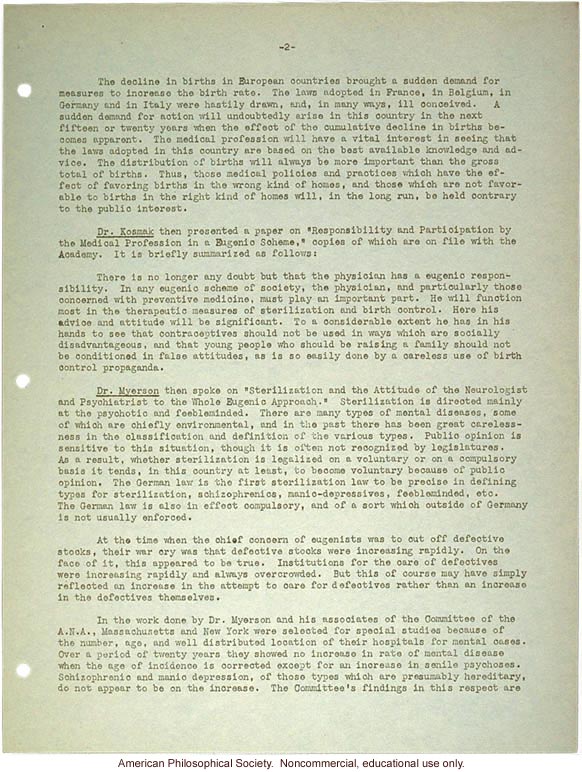[page number] -2- [end page number]
The decline in births in European countries brought a sudden demand for measures to increase the birth rate. The laws adopted in France, in Belgium, in Germany and in Italy were hastily drawn, and, in many ways, ill conceived. A sudden demand for action will undoubtedly arise in this country in the next fifteen or twenty years when the effect of the cumulative decline in births becomes apparent. The medical profession will have a vital interest in seeing that the laws adopted in this country are based on the best available knowledge and advice. The distribution of births will always be more important than the gross total of births. Thus, those medical policies and practices which have the effect of favoring births in the wrong kind of home will, in the long run, be held contrary to the public interest.
Dr. Kosmak then presented a paper on "Responsibility and Participation by the Medical Profession in a Eugenic Scheme," copies of which are on file with the Academy. It is briefly summarized as follows:
There is no longer any doubt but that the physician has a eugenic responsibility. In any eugenic scheme of society, the physician, and particularly those concerned with preventive medicine, must play an important part. He will function most in the therapeutic measures of sterilization and birth control. Here his advice and attitude will be significant. To a considerable extent he has in his hands to see that contraceptives should not be used in ways which are socially disadvantageous, and that young people who should be raising a family should not be conditioned in false attitudes, as is so easily done by a careless use of birth control propaganda.
Dr. Myerson then spoke on "Sterilization and the Attitude of the Neurologist and Psychiatrist to the Whole Eugenic Approach." Sterilization is directed mainly at the psychotic and feebleminded. There are many types of mental diseases, some of which are chiefly environmental, and in the past there has been great carelessness in the classification and definition of the various types. Public opinion is sensitive to this situation, though it is often not recognized by legislatures. As a result, whether sterilization is legalized on a voluntary or on a compulsory basis it tends, in this country at least, to become voluntary because of public opinion. The German law is the first sterilization law to be precise in defining types for sterilization, schizophrenics, manic-depressives, feebleminded, etc. The German law is also in effect compulsory, and of a sort which outside of Germany is not usually enforced.
At the time when the chief concern of eugenists was to cut off defective stocks, their war cry was that defective stocks were increasing rapidly. On the face of it, this appeared to be true. Institutions for the care of defectives were increasing rapidly and always overcrowded. But this of course may have simply reflected an increase in the attempt to care for defectives rather than an increase in the defectives themselves.
In the work done by Dr. Myerson and his associates of the Committee of the A.N.A., Massachusetts and New York were selected for special studies because of the number, age, and well distributed location of their hospitals for mental cases. Over a period of twenty years they showed no increase in rate of mental disease when the age of incidence is corrected except for an increase in senile psychoses. Schizophrenic and manic depression, of those types which are presumably hereditary, do not appear to be on the increase. The Committee's findings in this respect are


